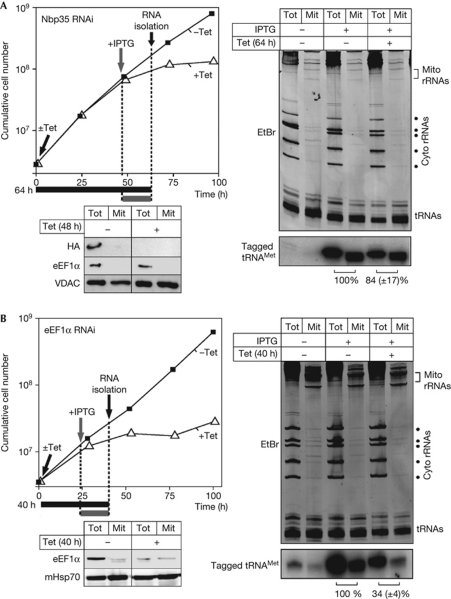Figure 1.
Ablation of eEF1α, but not Nbp35, affects mitochondrial transfer RNA import. (A) Left top panel: growth curve (±Tet) of a representative clonal IPTG- and Tet-inducible Nbp35 RNAi cell line. 1 μg/ml Tet and/or 1 mM IPTG were added before RNA isolation at the time points and for the durations indicated by black and grey arrows and bars, respectively. Left bottom panel: an immunoblot analysis containing total cellular (Tot) and digitonin-purified mitochondrial fractions (Mit) of Tet-uninduced and Tet-induced RNAi cells expressing HA-tagged Nbp35. The blot was probed with anti-sera recognizing the HA tag (HA), eEF1α and VDAC. Right top panel: EtBr stain of total cellular (Tot) and digitonin-extracted mitochondrial RNA fractions (Mit) separated on an 8 M urea and 10% polyacrylamide gel. RNA was isolated from cell cultures, treated as indicated. Right bottom panel: the corresponding northern blot probed for the tagged tRNAMet. Relative import efficiencies of the tagged tRNAMet are indicated at the bottom. The ratio between the signals in the total and the mitochondrial RNA fractions in the culture growing in the absence of Tet was set to 100%. Loading differences between the − and +Tet fractions were corrected for by quantification of the tRNA region on the EtBr stain. Experiments were done in triplicate, the standard error is indicated. (B) As in (A), but analysis was done with an eEF1α RNAi cell line. Cyto, cytosolic; eEF1α, elongation factor 1α; EtBr; ethidium bromide; HA, haemagglutinin; IPTG, isopropyl-β-D-thiogalactopyranoside; mHsp70, mitochondrial heat-shock protein 70; RNAi, RNA interference; rRNA, ribosomal RNA; Tet, tetracycline; tRNA, transfer RNA; VDAC, voltage-dependent anion channel.

